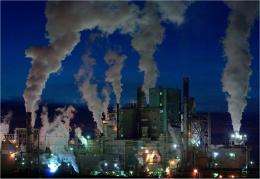Gases given off at night from power plants get converted into ultrafine organosulfate and organonitrate particles by morning, contributing to haze and air quality problems. Credit: Scott Butner.
Many studies show how daytime emissions from coal-fired power plants lead to ultrafine particles, linked to climate and health issues. But few studies watch what happens at night, when conditions favor different reactions. Now, thanks to a team of scientists led by Dr. Rahul Zaveri of Pacific Northwest National Laboratory, we know pollutant gases given off at night, which remain concentrated in the atmosphere, can react with naturally occurring compounds to form troubling aerosols.
These ultrafine aerosols are a major component of haze and contribute to health problems, such as chronic bronchitis, and are enough of a concern that the Environmental Protection Agency regulates their concentrations. These pollution particles are also implicated in climate change issues at regional and global scales. The present work will lead to better computer models for air pollution, which do not currently take into account the nighttime birth and growth of ultrafine particles.
The team of scientists performed 17 research flights using the U.S. Department of Energy's (DOE's) Gulfstream-1 aircraft during the 2002 New England Air Quality Study field campaign. During the day, regional surveys were performed in the southern New England and Mid-Atlantic states. The nighttime data were gathered over the Boston urban area and in the Salem Harbor power plant plume. Repeated aircraft sampling in the power plant plume was guided by a constant-altitude Mylar balloon (filled with helium and air) that was released near the power plant at sunset. The balloon was equipped with small, light-weight instruments to measure temperature, pressure, humidity, and ozone. The balloon also carried a GPS transmitter to allow the scientists onboard the aircraft to locate its position as it floated downwind through the course of a night.
On the evening of July 30, 2002, the team tracked the Salem Harbor power plant plume with the help of the balloon for a period of 7 hours over a distance of 170 miles, from Boston to about 85 miles south of Martha's Vineyard. The specialized instruments onboard the aircraft sampled the plume for aerosol particle size distribution and composition as well as concentrations of pollutant gases such as sulfur dioxide, nitric oxide, nitrogen dioxide, ozone, and volatile organic compounds (VOCs).
In analyzing this data, a multi-year task, the team found that at night, the concentrated power plant exhaust creeps atop the temperature inversion in the air where the atmosphere is relatively calm, allowing time for different kinds of chemical reactions that might not occur during the day. In the absence of photooxidation, ultrafine sulfate particles form from the small amounts of sulfuric acid that is often directly emitted from the power plant. Additional aerosol mass composed of organosulfate and organonitrate chemicals can then form via nitrogen oxide-initiated oxidation of VOCs from natural vegetation (e.g., isoprene) in the presence of highly acidic ultrafine particles.
Further laboratory, field, and modeling studies are needed to fully understand the complex nighttime aerosol chemistry in the atmosphere, and how the nocturnal pollution contributes to poor air quality, health problems, and climate change.
More information: Zaveri RA, et al. 2010. "Nighttime chemical evolution of aerosol and trace gases in a power plant plume: Implications for secondary organic nitrate and organosulfate aerosol formation, NO3 radical chemistry, and N2O5 heterogeneous hydrolysis." Journal of Geophysical Research-Atmospheres 115: D12304. DOI:10.1029/2009JD013250
Provided by Pacific Northwest National Laboratory




















